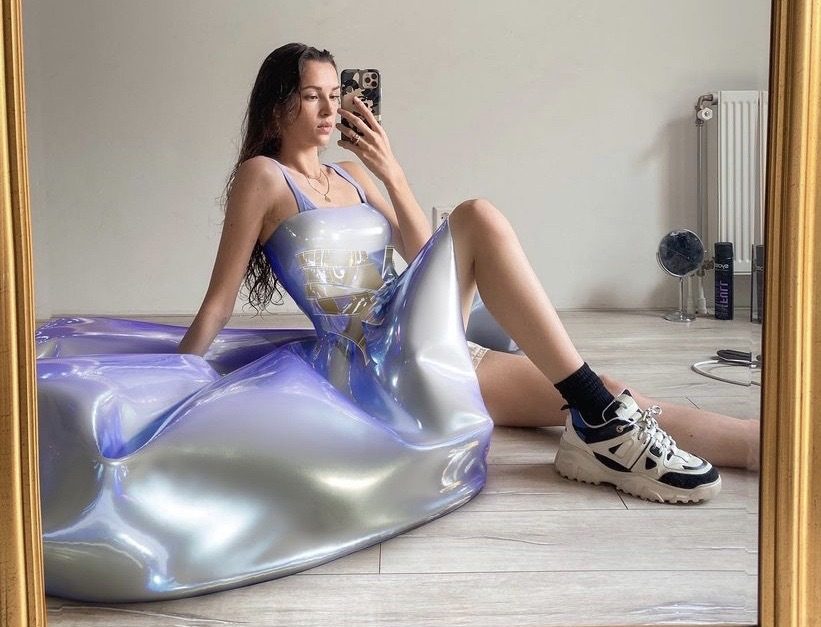Could your next shirt be made entirely out of pixels?
In 2019, a digital dress made only out of pixels sold for $9500. Two years later, the market for cyber fashion grew tremendously, partially due to the pandemic.
What is a digital dress?
Digital clothing is sold online as a virtual item that is edited onto the customer instead of them actually wearing it. On a small scale, this can be in the form of a paid Snapchat filter. On a larger scale, the piece of clothing can be sold as an NFT that one person uniquely owns.
Read more: NFTs: Why are memes selling for millions online?
In the case of the $9500 dress, it’s edited onto the owner using 3D modelling, so it looks like she’s wearing the dress when in fact, it was never even produced.
Why would anyone want this?
There are a few selling points to digital fashion that differentiate it from buying clothes you can wear. Due to the rise of fast fashion, people need new clothes without the hassle of storing and purchasing them. It’s reported that one in three women consider a piece of clothing “old” after just one or two wears. Additionally, a sixth of young people claim they won’t wear an outfit if it’s already been posted to their social media.
Fast fashion is not the only selling point, though. Digital clothing is more environmentally friendly as it doesn’t require physical resources to produce and distribute it. This is particularly important as almost ten percent of greenhouse gas emissions are produced by the fashion industry, and more than half of clothing ends up in landfill sites.
Another factor contributing to the rising trend of digital fashion is that physics doesn’t constrain such clothing. Companies are instead given the freedom to try out radically new designs that wouldn’t be possible to produce in real life.

Digital clothing isn’t all that new; in fact, it’s existed in online games for decades.
Fortnite generates revenue solely by selling skins, cosmetics and in-game items that add no functionality beyond visual changes. It’s not just Fortnite though, the market of skins in gaming is estimated to reach $50 billion by 2026.
Recently, a player of the Roblox online game purchased Gucci’s Dionysus bag for over $4000 – which is more than the price of the actual bag in real life.
Digital clothes on digital models

While digital clothes may revolutionise how human models dress up, it’s only the tip of the iceberg for what’s potentially the future of modelling.
Over the past few years, companies such as The Diigitals 3D generated computer models that have taken the industry by storm. Shudu, the world’s first digital supermodel, has more than 200,000 followers on Instagram.
These trends tease a future where the difference between reality and virtual are increasingly blurred.
Read more: Dystopian tech is already here and this is why you should worry
Will we virtually dress up in the future?
The digital clothing industry was accelerated due to the pandemic, but its presence in the future of society is inevitable.
Tech companies including Apple, Facebook, Google and Snapchat are all developing augmented reality [AR] experiences. AR works as an overlay between the real world and the digital world, allowing a seamless blend between both. This includes games such as Pokemon GO, as well as Snapchat filters that add objects to your room through your phone’s camera.
Tim Cook, CEO of Apple, has repeatedly expressed his excitement for AR. It’s reported that the company plans to release AR glasses in the next few years.

Combining AR with digital fashion could mean we would live in a world where what people wear in real life is different to what we see through AR glasses. An ordinary shirt could, for example, be transformed into an animated one that we only really experience through AR.
This may sound like science fiction, but it’s likely not too distant in the future. When AR filters were first introduced to Snapchat, they were really inaccurate, but now they’ve come a long way. We can now use filters that change the shapes of our faces, the colour of our hair, and more while still maintaining a realistic appearance.
We may not know it, but we’re all playing our role in advancing the field of digital fashion. When the technology is finally ready, we may just find that we are too.
Follow Doha News on Twitter, Instagram, Facebook and Youtube







